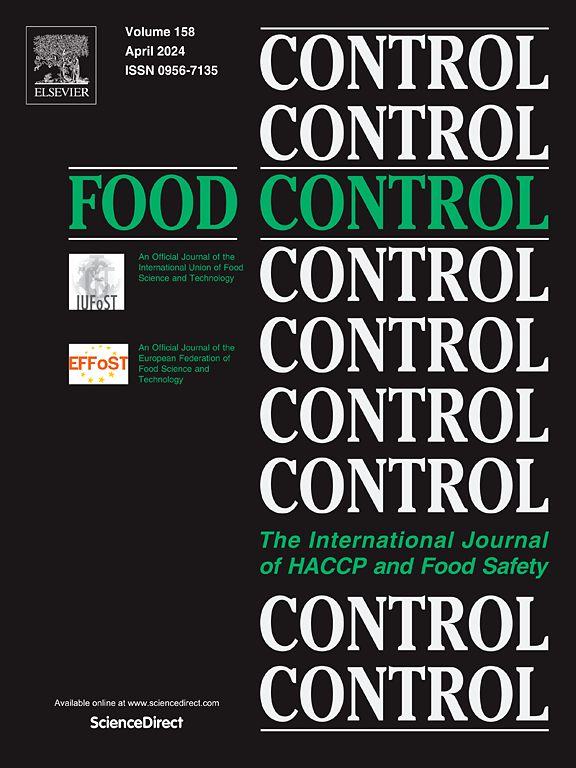Non-contact preservation of chilled chicken: extending shelf life and modulating microbial dynamics using solid spice essential oils and modified atmosphere packaging
IF 5.6
1区 农林科学
Q1 FOOD SCIENCE & TECHNOLOGY
引用次数: 0
Abstract
Non-contact preservation of meat remains a challenging and active area of research in the food industry. In this study, a non-contact solid spice essential oils preservative (SSEP) was developed and combined with modified atmosphere packaging (MAP, 30 % CO2 + 70 % N2) for the preservation of chilled fresh chicken. The results showed that SSEP, with essential oils (EOs) loading capacity of 29.49 % (rosemary: cinnamon = 1:1, w/w), exhibited significant antibacterial activity against both Staphylococcus aureus and Escherichia coli. Storage tests demonstrated that the combination of SSEP and MAP effectively delayed spoilage of chicken breast samples, as evidenced by a decrease in total volatile basic nitrogen (TVB-N), total viable count (TVC), and thiobarbituric acid reactive substances (TBARS) by 16.19 %, 32.21 % and 21.28 %, respectively, compared to the MAP-only group after 14 days of storage. High-throughput sequencing revealed that Pseudomonas spp. was the predominant bacteria in control group, while Carnobacterium spp., Serratia spp. and Lactococcus spp. were the predominant bacteria in MAP group. The combination of SSEP and MAP significantly reduced the relative abundance of spoilage bacteria and extended the shelf life by inhibiting the growth of Pseudomonas spp., Carnobacterium spp., Serratia spp. and Lactococcus spp. These findings propose a promising approach for non-contact meat preservation, enhancing the safety and quality of poultry products during refrigerated storage.
冷藏鸡肉的非接触保存:使用固体香料精油和改性大气包装延长保质期和调节微生物动力学
在食品工业中,肉类的非接触保存仍然是一个具有挑战性和活跃的研究领域。本研究开发了一种非接触式固体香料精油保鲜剂(SSEP),并将其与改性气相包装(MAP, 30% CO2 + 70% N2)相结合,用于冷藏鲜鸡肉的保鲜。结果表明,SSEP精油负荷量为29.49%(迷迭香:肉桂= 1:1,w/w),对金黄色葡萄球菌和大肠杆菌均有显著的抑菌活性。贮藏试验表明,SSEP和MAP可有效延缓鸡胸肉样品的变质,贮藏14 d后,SSEP和MAP可使鸡胸肉样品的总挥发性碱性氮(TVB-N)、总活菌数(TVC)和硫代巴比妥酸活性物质(TBARS)含量分别比单独使用MAP组降低16.19%、32.21%和21.28%。高通量测序结果显示,对照组以假单胞菌为主,MAP组以肉杆菌、沙雷氏菌和乳球菌为主。SSEP和MAP联合使用可显著降低腐败菌的相对丰度,并通过抑制假单胞菌、肉杆菌、沙雷氏菌和乳球菌的生长来延长保质期,为非接触肉类保鲜提供了一条有前景的途径,提高了家禽产品在冷藏过程中的安全性和质量。
本文章由计算机程序翻译,如有差异,请以英文原文为准。
求助全文
约1分钟内获得全文
求助全文
来源期刊

Food Control
工程技术-食品科技
CiteScore
12.20
自引率
6.70%
发文量
758
审稿时长
33 days
期刊介绍:
Food Control is an international journal that provides essential information for those involved in food safety and process control.
Food Control covers the below areas that relate to food process control or to food safety of human foods:
• Microbial food safety and antimicrobial systems
• Mycotoxins
• Hazard analysis, HACCP and food safety objectives
• Risk assessment, including microbial and chemical hazards
• Quality assurance
• Good manufacturing practices
• Food process systems design and control
• Food Packaging technology and materials in contact with foods
• Rapid methods of analysis and detection, including sensor technology
• Codes of practice, legislation and international harmonization
• Consumer issues
• Education, training and research needs.
The scope of Food Control is comprehensive and includes original research papers, authoritative reviews, short communications, comment articles that report on new developments in food control, and position papers.
 求助内容:
求助内容: 应助结果提醒方式:
应助结果提醒方式:


